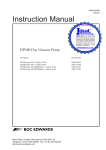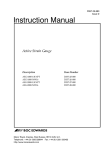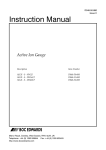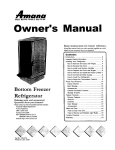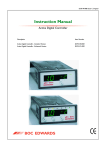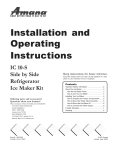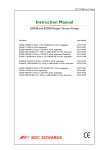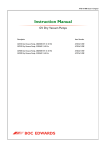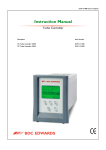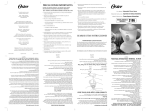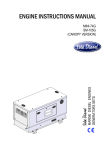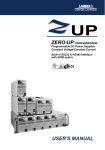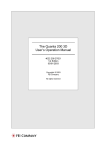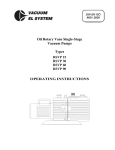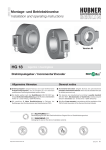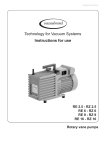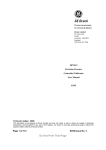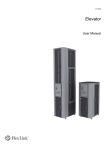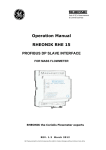Download Instr Manual: GVSP30 Scroll Pump - en
Transcript
A710-04-880 Issue C Original Instruction Manual GVSP30 Scroll Pump Description Item Number GVSP30 Scroll Pump, 3-phase, 200/208/230/380-460 V, 50/60 Hz GVSP30 Scroll Pump, 1-phase, 100/115/200/230 V, 50/60 Hz A710-04-907 A710-04-909 This page intentionally blank. GVSP30 Scroll Pump CONTENTS PAGE Ipsitech 8114-03 Section 1 INTRODUCTION 1 1.1 1.2 Scope and definitions Description 1 1 2 TECHNICAL DATA 3 2.1 2.2 2.3 2.4 2.5 2.6 2.7 Operating and storage conditions Performance Mechanical data Gas-ballast supply (optional) Noise and vibration data Electrical data Materials exposed to vacuum 3 3 3 3 3 4 4 3 INSTALLATION 7 3.1 3.2 3.3 3.4 3.5 3.6 3.6.1 3.6.2 3.6.3 3.7 3.8 3.9 3.10 3.11 Safety System requirements Unpack and inspect Reconfigure the pump (optional) Locate the pump Connect the electrical supply Introduction Connect to 3-phase pumps Connect to 1-phase pumps Check the direction of motor rotation Connect the pump inlet to the vacuum system Connect the pump outlet Configure the gas-ballast system (if necessary) Leak test the pump installation 7 7 7 8 8 9 9 9 9 12 12 13 13 13 4 OPERATION 14 4.1 4.2 Start-up Shut-down 14 14 5 MAINTENANCE 15 5.1 5.2 5.3 5.4 Safety information Inspect the system Inspect the inlet screen Service 15 15 16 16 6 STORAGE AND DISPOSAL 17 6.1 6.2 Storage Disposal 17 17 Dec 03 i Page i Issue C GVSP30 Scroll Pump CONTENTS (CONTINUED) PAGE Section ii Page 7 SERVICE, SPARES AND ACCESSORIES 18 7.1 7.2 7.3 7.4 Introduction Service Spares Accessories 18 18 18 18 RETURN OF BOC EDWARDS EQUIPMENT ILLUSTRATIONS Figure 1 2 3 4 5 6 7 8 Page The GVSP30 pump (3-phase pump shown) Pump dimensions (mm): 3-phase pump shown Pumping speed/pressure graph (m3 h-1) Pumping speed/pressure graph (cfm) Motor terminal-box low-voltage configuration: 3-phase pumps Motor terminal-box high-voltage configuration: 3-phase pumps Motor terminal-box low-voltage configuration: 1-phase pumps Motor terminal-box high-voltage configuration: 1-phase pumps 2 5 6 6 10 10 11 11 TABLES Table 1 2 3 4 5 6 7 8 9 10 11 Dec 03 Page Operating and storage conditions Performance data Mechanical data Gas-ballast supply data Noise and vibration data Electrical data: general Electrical data: 1-phase pumps Electrical data: 3-phase pumps Materials exposed to vacuum Spares Item Numbers Accessory Item Number 3 3 3 3 3 4 4 4 4 18 18 ii Issue C GVSP30 Scroll Pump 1 INTRODUCTION 1.1 Scope and definitions 1.2 Description Read this manual before you install and operate your pump. Important safety information is highlighted as WARNING and CAUTION instructions; you must obey these instructions. The use of WARNINGS and CAUTIONS is defined below. If you want to pump condensable vapours, or if you will regularly use the GVSP30 to pump down from atmospheric pressure in a humid environment (for example, if relative humidity exceeds 60%), you must use gas ballast (refer to Section 3.10). Inlet gas temperatures should not exceed 50 oC. If you need to pump gases above this temperature, install a chiller in the foreline, otherwise premature failure of the pump may occur. WARNING Warnings are given where failure to observe the instruction could result in injury or death to people. The body of the pump includes stationary scrolls (5) and an orbiting scroll. The orbiting scroll is driven by the electric motor through an eccentric cam on the motor drive shaft. The movement of the orbiting scroll, meshed with the stationary scrolls, forms successive crescent shaped volumes in the pump. CAUTION Cautions are given where failure to observe the instruction could result in damage to the equipment, associated equipment and process. The units used throughout this manual conform to the SI international system of units of measurement. Gas which enters the pump through the inlet (2) is compressed by the movement of the orbiting scroll and swept towards the centre of the stationary scrolls. The compressed gas enters the exhaustport near the centre of the stationary scrolls and is exhausted from the pump through the outlet (4). For displacement and pumping speed, the term ‘cfm’ is also used to mean ft3 min-1. The following warning labels are on the pump: The pump inlet (2) has an inlet screen which prevents the entry of debris into the pump. Warning - refer to accompanying documentation. The pump is air-cooled and has an electric motor and an hours counter (14) which operates when the electrical supply to the pump is switched on. Warning - risk of electric shock. Dec 03 1 Issue C PAGE 1 INTRODUCTION This manual provides installation, operation and maintenance instructions for the BOC Edwards GVSP30 Scroll Pump. You must use the pumps as specified in this manual. Refer to Figure 1. The GVSP30 is a compact, reliable vacuum pump designed for use on clean processes. The GVSP30 pump is not suitable for use with explosive, flammable, toxic or corrosive substances, or substances which contain particulates, or powders. GVSP30 Scroll Pump PAGE 2 INTRODUCTION 1. Lifting-eye 2. Inlet-port and inlet screen (in the inlet-port) 3. Fan cover 4. Outlet-port 5. Stationary scrolls 6. Cooling-fins 7. Direction of rotation arrow 8. Gas-ballast filter 9. Gas-ballast inlet 10. Motor terminal-box 11. Motor end-cover 12. Base-plate 13. Mounting-bolts (4 off) 14. Hours counter 15. Bolts (4 off) 16. Jacking holes 17. Coupling-cover bolts (5 off) 18. Location dowels (2 off) Figure 1 - The GVSP30 pump (3-phase pump shown) Issue C 2 Dec 03 GVSP30 Scroll Pump 2 TECHNICAL DATA 2.1 Operating and storage conditions PAGE 3 TECHNICAL DATA 5 to 40 oC -20 to 60 oC Ambient operating temperature range Ambient storage temperature range Table 1 - Operating and storage conditions 2.2 Performance 1 x 10-2 mbar, 1 Pa 1000 mbar, 1 x 105 Pa, 0 psig 1150 mbar, 1.15 x 105 Pa, 2 psig < 1 x 10-4 mbar l s-1, 1 x 10-2 Pa l s-1 Ultimate pressure Maximum inlet pressure Maximum outlet pressure Leak tightness Displacement (swept volume) 50 Hz electrical supply 60 Hz electrical supply Pumping speed Peak pumping speed 50 Hz electrical supply 60 Hz electrical supply 29.5 m3 h-1 (17.4 cfm) 35.1 m3 h-1 (20.7 cfm) See Figure 3 and Figure 4 25 m3 h-1 (14.7 cfm) 30 m3 h-1 (17.6 cfm) Table 2 - Performance data 2.3 Mechanical data Dimensions Mass 1-phase pump 3-phase pump See Figure 2 Inlet connection Outlet connection Gas-ballast inlet connection NW40 NW25 1/ inch BSP 8 44 kg 38 kg Table 3 - Mechanical data 2.4 Gas-ballast supply (optional) 0.5 bar gauge, 1.5 x 105 Pa 10 slm Maximum gas supply pressure Nominal gas flow rate Table 4 - Gas-ballast supply data 2.5 Noise and vibration data Noise level (at 1 m from the pump, measured in an anechoic room) 1-phase pump 3-phase pump Vibration velocity (at the inlet flange) < 62 dB(A) < 60 dB(A) < 1.5 mm s-1 Table 5 - Noise and vibration data Dec 03 3 Issue C GVSP30 Scroll Pump 2.6 PAGE 4 Electrical data Electrical supply Full load current ratings See Table 7 and Table 8 See Table 7 and Table 8 Table 6 - Electrical data: general TECHNICAL DATA Electrical supply voltage 100 115 200 230 8.5 10.0 8.6 4.3 4.8 3.9 4.0 1430 1660 1720 1430 1690 1450 1730 Full load current rating: A 50 Hz 60 Hz Motor rotational speed: r min-1 50 Hz 60 Hz Table 7 - Electrical data: 1-phase pumps Electrical supply voltage 200 208 230 380 415 460 2.7 2.8 2.6 2.5 1.57 - 1.63 - 1.47 1460 1740 1740 1760 1470 - 1470 - 1770 Full load current rating: A 50 Hz 60 Hz Motor rotational speed: r min-1 50 Hz 60 Hz Table 8 - Electrical data: 3-phase pumps 2.7 Materials exposed to vacuum Materials exposed to vacuum PTFE (polytetrafluoroethylene) impregnated aluminium, stainless steel, steel bearings, PFPE (perfluoropolyether) grease, fluoroelastomer seals. Table 9 - Materials exposed to vacuum Issue C 4 Dec 03 GVSP30 Scroll Pump PAGE 5 TECHNICAL DATA A Side view B Front view (inlet/ outlet as supplied) C Bottom view D Front view (alternative inlet/outletpositions) 1. 2. 3. 4. 5. 6. Inlet-port Gas-ballast inlet Alternative inlet-port position Alternative outlet-port position Outlet-port M8 mounting holes (4 off) Pump A B 1-phase 3-phase 443 372 194 123 Figure 2 - Pump dimensions (mm): 3-phase pump shown Dec 03 5 Issue C GVSP30 Scroll Pump PAGE 6 TECHNICAL DATA 1. 60 Hz 2. 50 Hz Figure 3 - Pumping speed/pressure graph (m3 h-1) 1. 60 Hz 2. 50 Hz Figure 4 - Pumping speed/pressure graph (cfm) Issue C 6 Dec 03 GVSP30 Scroll Pump 3 INSTALLATION 3.2 3.1 Safety Consider the following points when you design your pumping system: • Support the vacuum pipelines to stop the transmission of stress to the pipeline joints. Obey the safety instructions given below and take note of appropriate precautions. If you do not, you can cause injury to people and damage to equipment. • You must be able to isolate the pump inlet and outlet from the atmosphere and from your vacuum system if you have pumped dangerous gases. • A suitably trained and supervised technician must install your GVSP30 pump. 3.3 Unpack and inspect • Ensure that the installation of the pump conforms with all the requirements of your local and national safety standards. Ensure that your control system is configured so that the pumping system is safe if the electrical supply fails. 1. Place the carton in a convenient position with a fork-lift truck or a pallet truck. 2. Remove all packing materials. 3. Use the lifting-handle (Figure 1, item 1) to lift the pump from its carton. • Ensure that the installation technician is familiar with the safety precautions for the gases processed by the pumping system. Wear the appropriate safety-clothing when you come into contact with contaminated components. Vent and purge the pumping system before you start installation work. 4. Remove all protective covers and inspect the pump. If the pump is damaged, notify your supplier and the carrier in writing within three days; state the Item Number of the pump together with your order number and your supplier’s invoice number. Retain all packing materials for inspection. Do not use the pump if it is damaged. 5. If you want to connect an inert gas ballast supply to the GVSP30 (see Section 3.10), check that you have received a gas-ballast blanking cap with the pump; if the blanking cap is missing, notify your supplier in writing within three days. 6. If the pump is not to be used immediately, replace the protective covers. Store the pump in suitable conditions as described in Section 6.1. • Disconnect the other components in the pumping system from the electrical supply so that they cannot be operated accidentally. • Do not reuse 'O' rings and Co-Seals if they are damaged. Dec 03 7 Issue C PAGE 7 INSTALLATION WARNING System requirements GVSP30 Scroll Pump 3.4 PAGE 8 12. Turn the outlet flange through 180o (so that it is orientated as shown in Figure 2, item 4), ensure that the 'O' ring seal is correctly located, then refit the outlet flange (4) to the pump and secure with the four bolts (15). Reconfigure the pump (optional) INSTALLATION Refer to Figure 2. The pump is supplied with the inlet flange at the top of the pump (as shown in detail B). If required, you can move the inlet flange to the side of the pump (as shown in detail D); refer to Figure 1 and use the following procedure: 1. Lift the pump into a vertical position so that it rests on the motor end-cover (11). 2. Undo and remove the four bolts which secure the fan cover (3) to the body of the pump. Remove the fan cover. 3. Undo and remove the five bolts (17) which secure the body of the pump to the motor. 4. Lift the body of the pump clear of the motor. If you cannot lift the body of the pump off of the motor, place two of the bolts removed in Step 3 in the jacking holes (16), then tighten the bolts to push the body of the pump away from the motor. 5. 6. 7. 3.5 CAUTION Locate the pump so that it is on a firm, level floor; the inclination of the floor must not exceed 5o. If you do not locate the pump correctly, seals in the pump may wear quickly and the performance of the pump will deteriorate. Ensure that the pump is not installed in an enclosed area. The pump requires a cooling-air flow rate of 8 m3 min-1. The cooling-fans will provide this flow rate if the pump is not installed in a restricted space. Refer to Figure 1. Attach suitable lifting-gear to the lifting-eye (1) on the pump and move the pump to its final operating position. Note that: Turn the body of the pump through 90o, so that the inlet flange (2) is at the side of the pump. • The pump can be free-standing; if required, adjust the bolts (13) to stabilise the pump. Ensure that the flexible coupling and the two locating dowels (18) are correctly aligned, then lower the body of the pump back onto the motor shaft. • If required, you can remove the fixing-bolts (13) and fit other suitable bolts through the mounting-holes (Figure 2, items 6) in the base-plate of the pump to secure the pump to the floor. Turn the cooling-fan and check that the pump mechanism rotates smoothly. If you cannot turn the fan easily, the body of the pump is not correctly aligned on the motor. 8. Use the five bolts (17) removed in Step 3 to secure the body of the pump to the motor. 9. Use the four bolts removed in Step 2 to secure the fan cover (3) to the body of the pump. Locate the pump • If required, you can fit vibration isolators below the base-plate. Suitable vibration isolators are available as optional accessories (see Section 7.4). 10. Turn the pump over so that it rests on the baseplate (12). 11. Remove the four bolts (15) and remove the outlet flange (4) and 'O' ring seal from the pump body. Issue C 8 Dec 03 GVSP30 Scroll Pump 3.6 7. Connect the electrical supply Connect the wires at the other end of the cable to your electrical supply. PAGE CAUTION 3.6.3 3.6.1 1. Remove the cover from the motor terminalbox (Figure 1, item 10). 2. Check your electrical supply voltage and frequency. The universal motor of the pump can be configured for `low-voltage' operation (100-115 V) as shown in Figure 7, or for 'highvoltage' operation (200-230 V), as shown in Figure 8. If necessary, reconfigure the motor to operate with your supply voltage. 3. Fit a suitable 20 mm cable-gland to the cable leadthrough hole. If your cable is too large to pass through a 20 mm cable-gland, fit a 20 mm to 25 mm female thread adaptor to the cable entry-hole, and fit a 20 mm cable-gland to the adaptor. 4. Pass the electrical supply cable through the cable-gland. 5. Connect the neutral and live wires in the cable (N, L) to the X and Z terminals as shown in Figures 7 or 8, depending on your electrical supply voltage, then connect the earth (ground) wire in the cable to the earth (ground) stud in the terminal-box. 6. Tighten the cable-gland and refit the terminalbox cover. 7. Connect the wires at the other end of the cable to your electrical supply. Introduction Connect the electrical supply to the motor as described in Section 3.6.2 or 3.6.3. Connect the supply through a contactor which incorporates a circuit breaker suitable for the full load current ratings given in Tables 7 and 8. 3.6.2 1. 2. 3. Connect to 3-phase pumps Remove the cover from the motor terminalbox (Figure 1, item 10). Check your electrical supply voltage and frequency. The universal motor of the pump can be configured for `low-voltage' operation (200-230 V) as shown in Figure 5, or for 'highvoltage' operation (380-460 V), as shown in Figure 6. If necessary, reconfigure the motor to operate with your supply voltage. Fit a suitable 20 mm cable-gland to the cable leadthrough hole. If your cable is too large to pass through a 20 mm cable-gland, fit a 20 mm to 25 mm female thread adaptor to the cable entry-hole, and fit a 20 mm cable-gland to the adaptor. 4. Pass the electrical supply cable through the cable-gland. 5. Connect the phase wires in the cable (L1, L2, L3) to the U1, V1 and W1 terminals as shown in Figures 5 or 6, depending on your electrical supply voltage, then connect the earth (ground) wire in the cable to the earth (ground) stud in the terminal-box. 6. Tighten the cable-gland and refit the terminalbox cover. Dec 03 9 Issue C INSTALLATION The motor is not thermally protected. You must provide external overload protection. Branch circuit fuses must must have a maximum rating of 115% of the full load current rating given in Section 2.6. 9 Connect to 1-phase pumps GVSP30 Scroll Pump PAGE 10 INSTALLATION Figure 5 - Motor terminal-box low-voltage configuration: 3-phase pumps Figure 6 - Motor terminal-box high-voltage configuration: 3-phase pumps Issue C 10 Dec 03 GVSP30 Scroll Pump PAGE 11 INSTALLATION Figure 7 - Motor terminal-box low-voltage configuration: 1-phase pumps Figure 8 - Motor terminal-box high-voltage configuration: 1-phase pumps Dec 03 11 Issue C GVSP30 Scroll Pump 3.7 Check the direction of motor 3.8 rotation Connect the pump inlet to the vacuum system PAGE 12 Ensure that debris does not get into the pump when you install it. CAUTION INSTALLATION Ensure that debris and objects do not fall into the pump inlet and outlet when you check the direction of motor rotation. If this happens, you may damage the pump. Note: 1. 2. If the pump is to replace a pump in an existing system, purge the existing pump with nitrogen for 15 minutes before you disconnect it. When you switch off the pump, the cooling-fan may stop and then rotate in the reverse direction for a few revolutions. If the existing pump is an oil-sealed pump, we recommend that you dismantle the pipeline which connects the vacuum system to the pump and clean the pipeline to ensure that there is no residual oil contamination in the pipeline. Watch the cooling-fan from the motor end of the pump, switch on the pump for two or three seconds, then switch the pump off. Use standard NW40 fittings to connect the pumpinlet to your vacuum system. When you connect to the vacuum system: The correct direction of rotation of the cooling-fan is clockwise when viewed from the motor end of the pump and is indicated by the arrow on the coupling cover (see Figure 1, item 7). If the direction of rotation is incorrect: • To get the best pumping speed, ensure that the pipeline connected to the pump-inlet has an internal diameter not less than the inletport diameter, and is as short as possible. • On a 3-phase pump, isolate the pump from the electrical supply, swap any two of the phase-wires in the motor terminal-box, then reconnect the pump to the electrical supply and repeat Step 1 to ensure that the direction of rotation is now correct. • Incorporate flexible bellows in your system pipelines to reduce the transmission of vibration and to prevent loading of couplingjoints. The bellows must have a maximum pressure rating which is greater than the highest pressure that can be generated in your system. We recommend that you use BOC Edwards flexible bellows. • On a 1-phase pump, do not use the pump; contact your supplier or BOC Edwards for advice. • Incorporate an inlet isolation-valve in the pipeline from the vacuum system to the pump, so that you can isolate the vacuum system from the pump when it is switched off and prevent the suck-back of process gases and debris into the vacuum system. Issue C 12 Dec 03 GVSP30 Scroll Pump 3.9 3.10 Connect the pump outlet Configure the gas-ballast system (if necessary) PAGE We recommend that you use an exhaust extractionsystem suitable for use with all of the process gases you will pump. Note that: Refer to Figure 1, detail B. If you want to use gasballast on your application: • Ensure that you minimise (or if possible, eliminate) the use of 'U' bends, in which condensates may collect. • Alternatively, you can remove the blanking cap (8) and fit an inert gas supply pipeline to the gasballast inlet (9). Note that: Use standard NW25 fittings to connect the pumpoutlet to the exhaust-extraction system. • The gas supply must comply with the requirements of Section 2.4. • The gas supply pipeline must incorporate a flow control valve, to allow you to control the gas ballast flow rate into the pump. • Apply a suitable thread sealant (such as Loctite 242) to the threads of the gas-ballast inlet prior to connection of the pipeline, to ensure the leak tightness of the gas-ballast system. If you require air gas-ballast on your application: remove the blanking cap and fit the filter (8) (supplied with the pump) to the gas-ballast inlet (9). 3.11 Leak test the pump installation Leak test the pump installation and seal any leaks found to prevent the leakage of dangerous substances from the system and the leakage of air into the system. When supplied, the leak tightness of the pump (with the gas-ballast inlet sealed) is less than 1 x 10-4 mbar l s-1 (1 x 10-2 Pa l s-1). Dec 03 13 Issue C INSTALLATION • As supplied, the gas-ballast system on the pump is closed, and has a blanking cap fitted to the gasballast inlet (9). The gas-ballast system incorporates a non-return valve, to prevent the leakage of pumped gas into the atmosphere. • You must ensure that the exhaust-extraction system cannot become blocked or obstructed when the pump is operating. 13 GVSP30 Scroll Pump 4 OPERATION 4.2 Shut-down PAGE CAUTION WARNING 14 Close the vacuum system isolation-valve before you switch off the pump. If you do not, particulate in the pump may be sucked back into your vacuum system. OPERATION Do not use the GVSP30 to pump powders or explosive, flammable, corrosive or toxic substances. If you do, there may be a risk of explosion or fire. CAUTION WARNING If the pump will be left switched off for a long time, ensure that you purge the pump as described below. If you do not, particulate or moisture in the pump may damage it and cause it to fail when you next try to operate it. Never switch the inert gas-ballast supply on or off when the pump is operating. If you do, there may be a risk of injury, or the pump may fail. Note: 4.1 Note: The following procedures assume that your system has an inlet isolation-valve which you can use to isolate the pump from your vacuum system, and a means to open the pump-inlet to atmosphere. Use the procedure below to shut down the pump. 1. Close the vacuum system isolation-valve (to prevent suck-back into the vacuum system). 2. If the pump will be left switched off for a long time: Start-up Use the procedure below to start up the pump. 1. Ensure that the vacuum system isolation-valve is closed. 2. If you have connected an inert gas supply to the gas-ballast inlet (see Section 3.10), switch on the inert gas supply and adjust the gas flow rate. 3. Switch on the electrical supply to the pump. 4. Open the vacuum system isolation-valve. Note: Issue C When you switch off the pump, the cooling-fan may stop and then rotate in the reverse direction for a few revolutions. • Open the pump-inlet to atmosphere. • Leave the pump to operate for a few minutes, to purge the pump of particulate and moisture which may have collected in the pump. If the pump fails to reach the specified ultimate pressure after a number of hours, either during initial start-up or after the pump has been shut down for a prolonged time, moisture in the pump may have affected its performance and you should use the following method to correct this: close the inlet isolation-valve and operate the pump for six to eight hours; briefly open the inlet to atmosphere two to three times per hour. 14 3. Switch off the electrical supply to the pump. 4. If you have connected an inert gas supply to the gas-ballast inlet (see Section 3.10), switch off the inert gas supply. Dec 03 GVSP30 Scroll Pump 5 MAINTENANCE 5.1 Safety information WARNING Obey the safety instructions given below and take note of appropriate precautions. If you do not, you can cause injury to people and damage to equipment. • A suitably trained and supervised technician must maintain your GVSP30 pump. • Leak test the system after maintenance work is complete if you have disconnected any vacuum or exhaust joints; seal any leaks found. • Ensure that the installation technician is familiar with the safety precautions for the gases pumped. Wear the appropriate safetyclothing when you come into contact with contaminated components. Vent and purge the pumping system before you start installation work. 5.2 The GVSP30 pump is designed to require little user maintenance. Do the following checks when you maintain your vacuum system: • Purge the vacuum system and the pump with dry nitrogen if you will disconnect any of the vacuum or exhaust connections. • Check that the vacuum connections are secure. • Disconnect and isolate the other components in the pumping system from the electrical supply so that they cannot be operated accidentally. • If fitted, check that the inert gas supply pipeline is securely connected to the gasballast inlet, and that the connection does not leak. • Take care to protect sealing-faces from damage. • Check that the electrical connections are secure and that the electrical cable is not damaged. • Do not reuse 'O' rings and Co-Seals if they are damaged. • Check that the cooling-fins on the pump are not obstructed or blocked. • Dispose of components, debris and used cleaning solution safely: refer to Section 6.2. Dec 03 Inspect the system • If necessary, replace the gas-ballast filter. 15 Issue C PAGE 15 MAINTENANCE • Do not touch or inhale the thermal breakdown products of fluorinated materials which may be present if the GVSP30 has been overheated to 260 oC and above. These breakdown products are very dangerous. Fluorinated materials in the GVSP30 include seals. The GVSP30 may have overheated if it was misused, if it malfunctioned, or if it was in a fire. BOC Edwards Material Safety Data Sheets for the fluorinated materials used in the GVSP30 are available on request: contact your supplier or BOC Edwards. GVSP30 Scroll Pump 5.3 PAGE 16 Inspect the inlet screen 5.4 Whenever you disconnect the pump from your vacuum system, we recommend that you: Service MAINTENANCE We recommend that the GVSP30 pump is serviced by BOC Edwards service engineers every year (if the pump is in continuous use) or every 8500 hours of pump operation. • Remove any debris trapped by the inlet screen (in the inlet-port). • Inspect the inlet screen and if necessary, clean it with a cleaning solution suitable for the substances pumped. We recommend that the pump is given a minor service after the first year (or 8500 hours), followed by a major service after the next year (or 8500 hours), followed by a minor service, and so on. To remove the inlet screen, remove the circlip which secures the inlet screen in the inlet-port. Contact your supplier or BOC Edwards to arrange these services. After you have inspected/cleaned the inlet screen, refit the inlet screen in the inlet-port and secure with the circlip before you reconnect the pump to your vacuum system. Issue C 16 Dec 03 GVSP30 Scroll Pump 6 STORAGE AND DISPOSAL 6.1 6.2 Shut-down the Section 4.2. described in 2. Isolate the pump from the electrical supply. 3. Purge the vacuum system and the GVSP30 pump with dry nitrogen. 4. Disconnect the GVSP30 pump from the vacuum system. 5. Place protective covers over the inlet and outlet-flanges. 6. Store the pump in cool, dry conditions until required for use. When required, prepare and install the pump as described in Section 3. Dec 03 Dispose of the pump and any components safely in accordance with all local and national safety and environmental requirements. Take particular care with components which have been contaminated with dangerous process substances. 17 Issue C STORAGE AND DISPOSAL 1. 17 Do not incinerate the pump, or any of the 'O' rings or other seals. Seals in the pump (and other seals) are made from fluorinated materials. The thermal breakdown products of fluorinated materials are very dangerous (see Section 5.1). Use the procedure below to store the pump. as PAGE WARNING Storage pump Disposal GVSP30 Scroll Pump 7 SERVICE, SPARES AND ACCESSORIES PAGE 18 7.1 7.2 Service SERVICE, SPARES AND ACCESSORIES BOC Edwards products are supported by a worldwide network of BOC Edwards Service Centres. Each Service Centre offers a wide range of options including: equipment decontamination; service exchange; repair; rebuild and testing to factory specifications. Equipment which has been serviced, repaired or rebuilt is returned with a full warranty. Introduction BOC Edwards products, spares and accessories are available from BOC Edwards companies in Belgium, Brazil, China, France, Germany, Israel, Italy, Japan, Korea, Singapore, United Kingdom, U.S.A and a world-wide network of distributors. The majority of these centres employ Service Engineers who have undergone comprehensive BOC Edwards training courses. Your local Service Centre can also provide BOC Edwards engineers to support on-site maintenance, service or repair of your equipment. For more information about service options, contact your nearest Service Centre or other BOC Edwards company. Order spare parts and accessories from your nearest BOC Edwards company or distributor. When you order, state for each part required: 7.3 Spares • Model and Item Number of your equipment Refer to Table 10 for the spares available for the ESDP12B pump. • Serial number • Item Number and description of part. 7.4 Accessories Fit vibration isolators to reduce vibration and noise when the ESDP12B pump is floor- or framemounted. The vibration isolators also help to reduce mechanical stresses when the pump is mounted on an uneven surface. Refer to Table 11 for the Item Number of the vibration isolators. R Spare Accessory Item Number Minor Service Kit * Major Service Kit Crank Pin Kit (1 only) Crank Pin Kit (set of 3) Motor Assembly: 1-phase Motor Assembly: 3-phase Tip Seals Kit * Pump Module Outlet Flange Inlet Flange Fan Cover Vibration isolators (pack of 4) A710-04-820 A710-04-800 A710-03-006 A710-04-006 A710-04-010 A710-04-011 A710-04-026 A710-04-030 A710-03-019 A710-04-016 A710-04-024 Item Number A248-01-404 Table 11 - Accessory Item Number Table 10 - Spares Item Numbers * These Kits are part of the Major Service Kit. Issue C 18 Dec 03 Form HS1 Return of BOC Edwards Equipment - Procedure INTRODUCTION Before returning your equipment, you must warn BOC Edwards if substances you used (and produced) in the equipment can be hazardous. This information is fundamental to the safety of our Service Centre employees and will determine the procedures employed to service your equipment. Complete the Declaration (HS2) and send it to BOC Edwards before you dispatch the equipment. It is important to note that this declaration is for BOC Edwards internal use only, and has no relationship to local, national or international transportation safety or environmental requirements. As the person offering the equipment for shipment, it is your responsibility to ensure compliance with applicable laws. P900-70-000 Issue K GUIDELINES • Equipment is 'uncontaminated' if it has not been used, or if it has only been used with substances that are not hazardous. Your equipment is 'contaminated' if it has been used with any substances classified as hazardous under EU Directive 67/548/EEC (as amended) or OSHA Occupational Safety (29 CFR 1910). • If your equipment has been used with radioactive substances, biological or infectious agents, mercury, polychlorinated biphenyls (PCB’s), dioxins or sodium azide, you must decontaminate it before you return it to BOC Edwards. You must send independent proof of decontamination (for example a certificate of analysis) to BOC Edwards with the Declaration (HS2). Phone BOC Edwards for advice. • If your equipment is contaminated, you must either: • Remove all traces of contamination (to the satisfaction of laws governing the transportation of dangerous/hazardous substances). • Or, properly classify the hazard, mark, manifest and ship the equipment in accordance with applicable laws governing the shipment of hazardous materials. Note: Some contaminated equipment may not be suitable for airfreight. PROCEDURE 1. Contact BOC Edwards and obtain a Return Authorisation Number for your equipment. 2. Complete the Return of BOC Edwards Equipment - Declaration (HS2). 3. If the equipment is contaminated, you must contact your transporter to ensure that you properly classify the hazard, mark, manifest and ship the equipment, in accordance with applicable laws governing the shipment of contaminated/hazardous materials. As the person offering the equipment for shipment, it is your responsibility to ensure compliance with applicable law. Note: Equipment contaminated with some hazardous materials, such as semiconductor by-products, may not be suitable for airfreight - contact your transporter for advice. 4. Remove all traces of hazardous gases: pass an inert gas through the equipment and any accessories that will be returned to BOC Edwards. Where possible, drain all fluids and lubricants from the equipment and its accessories. 5. Seal up all of the equipment's inlets and outlets (including those where accessories were attached) with blanking flanges or, for uncontaminated product, with heavy gauge tape. 6. Seal equipment in a thick polythene/polyethylene bag or sheet. 7. If the equipment is large, strap the equipment and its accessories to a wooden pallet. If the equipment is too small to be strapped to a pallet, pack it in a suitable strong box. 8. Fax or post a copy of the Declaration (HS2) to BOC Edwards. The Declaration must arrive before the equipment. 9. Give a copy of the Declaration (HS2) to the transporter. You must tell your transporter if the equipment is contaminated. 10. Seal the original Declaration in a suitable envelope: attach the envelope securely to the outside of the equipment package, in a clear weatherproof bag. WRITE YOUR RETURN AUTHORISATION NUMBER CLEARLY ON THE OUTSIDE OF THE ENVELOPE OR ON THE OUTSIDE OF THE EQUIPMENT PACKAGE. Form HS2 Return of BOC Edwards Equipment - Declaration Return Authorisation Number: You must: • Know about all of the substances which have been used and produced in the equipment before you complete this Declaration • Read the Return of BOC Edwards Equipment - Procedure (HS1) before you complete this Declaration • Contact BOC Edwards to obtain a Return Authorisation Number and to obtain advice if you have any questions • Send this form to BOC Edwards before you return your equipment SECTION 1: EQUIPMENT Equipment/System Name_________________________ IF APPLICABLE: Part Number _________________________________ Tool Reference Number_________________ Serial Number_________________________________ Process ______________________________ Has the equipment been used, tested or operated ? Failure Date___________________________ YES Serial Number of Replacement Equipment_________________ R Go to Section 2 NO R Go to Section 4 SECTION 2: SUBSTANCES IN CONTACT WITH THE EQUIPMENT Are any substances used or produced in the equipment: • • Radioactive, biological or infectious agents, mercury, poly chlorinated biphenyls (PCBs), dioxins or sodium azide? (if YES, see Note 1) YES NO R YES R Hazardous to human health and safety? R NO R Note 1 : BOC Edwards will not accept delivery of any equipment that is contaminated with radioactive substances, biological/infectious agents, mercury, PCB’s, dioxins or sodium azide, unless you: • • Decontaminate the equipment Provide proof of decontamination YOU MUST CONTACT BOC EDWARDS FOR ADVICE BEFORE YOU RETURN SUCH EQUIPMENT SECTION 3: LIST OF SUBSTANCES IN CONTACT WITH THE EQUIPMENT Chemical Symbol Substance name Precautions required (for example, use protective gloves, etc.) Action required after a spill, leak or exposure SECTION 4: RETURN INFORMATION Reason for return and symptoms of malfunction _________________________________________________ _________________________________________________________________________________ If you have a warranty claim: • who did you buy the equipment from ? _____________________________ • give the supplier’s invoice number_________________________________ SECTION 5: DECLARATION Print your name:_________________________________Print your job title:_________________________ Print your organisation:____________________________________________________________________ Print your address:_______________________________________________________________________ Telephone number: ___________________________Date of equipment delivery: ______________ I have made reasonable enquiry and I have supplied accurate information in this Declaration. I have not withheld any information, and I have followed the Return of BOC Edwards Equipment - Procedure (HS1). Signed: _____________________________________Date______________ Note: Please print out this form, sign it and return the signed form as hard copy. P900-71-000 Issue K _______________________________________________________________________ This page intentionally blank. UNITED KINGDOM CANADA ISRAEL CORPORATE HEADQUARTERS BOC EDWARDS Manor Royal Crawley West Sussex RH10 9LW Tel +(44) 1293 528844 Fax +(44) 1293 533453 BOC EDWARDS 5975 Falbourne Street Mississauga, Ontario L5R3W6 Canada Tel +(1) 905 501 2558 Fax +(1) 905 501 1632 EDWARDS ISRAEL VACUUM LTD. 5 Habarzel Blvd Gat 2000 Industrial Zone Qiryat Gat 82000 Tel +(972) 8 681 0633 Fax +(972) 8 681 0640 12055 Cote de Liesse Dorval, Quebec H9P1B4 Canada Tel +(1) 514 631 3501 Fax +(1) 514 631 3502 ITALY BOC EDWARDS Wingates Industrial Estate Great Bank Road Westhoughton, Bolton Lancashire BL5 3SL Tel +(44) 1942 652652 Fax +(44) 1942 652651 AMERICA (USA) USA HEADQUARTERS BOC EDWARDS One Edwards Park 301 Ballardvale Street Wilmington, MA 01887 Tel +(1) 978 658 5410 Toll free (USA only) 1 800 848 9800 Fax +(1) 978 658 7969 3901 Burton Drive Santa Clara, CA 95054 Tel +(1) 408 496 1177 Fax +(1) 408 496 1188 1810 West Drake Drive Suite 101 Tempe, AZ 85283 Tel +(1) 602 777 7007 Fax +(1) 602 777 2244 P800-80-000 Issue J 01A09-010 11701 Stonehollow Drive Suite 100 Austin, TX 78758 Tel +(1) 512 491 6622 Fax +(1) 512 491 0629 CHINA BOC TRADING (SHANGHAI) CO. LTD. 23 Fu Te Road (N) Wai Gao Qiao Free Trade Zone Pudong Shanghai, 200131 PRC China Tel +(86 21) 5866 9618 Fax +(86 21) 5866 9993 HEADQUARTERS BOC EDWARDS Shuwa Shiba Park Building A-3F 2-4-1 Shibakoen Minato-ku Tokyo, 105-0011 Tel +(81) (0) 3 5470 6530 Fax +(81) (0) 3 5470 6521 KOREA BOC EDWARDS 125 Avenue Louis Roche 92238 Gennevilliers, Cedex Paris Tel +(33) 1 47 98 24 01 Fax +(33) 1 47 98 44 54 HEADQUARTERS SONGWON EDWARDS LTD. 5th FL. Daewoo Engineering Bldg. Soonae-dong Bundang-gu, Sungnam City Kyungki-do, Korea Tel +(82) 31 716 7070 Fax +(82) 31 738 1001-3 GERMANY BOC EDWARDS Ammerthalstraße 36 85551 Kirchheim Munich Tel +(49) 89 99 19 18 0 Fax +(49) 89 99 19 18 99 HONG KONG S.A.R. 3501 Island Avenue Philadelphia, PA 19153 Tel +(1) 215 365 8653 Fax +(1) 978 753 6846 BELGIUM INDIA BOC EDWARDS Bergensesteenweg 709 B1600 Sint-Pieters-Leeuw Brussels Tel +(32) 2 363 0030 Fax +(32) 2 363 0064 BOC EDWARDS DIVIN. OF BOC INDIA LIMITED 203 Surya Kiran Building 19 Kasturba Gandhi Marg New Delhi - 110 001 India Tel +(91) 11 851 0065 Fax +(91) 11 851 0245 BOC DO BRASIL LTDA DIVISÃO EDWARDS ALTO VACO Rua Bernado Wrona 222 02710 São Paulo-SP Tel +(55) 11 3952 5000 Fax +(55) 11 3965 2766 JAPAN FRANCE BOC EDWARDS (ASIA) 12 Chun Yat Street Tseung Kwan O Industrial Estate Tseung Kwan O, Kowloon Hong Kong S.A.R. Tel +(852) 2372 2640 Fax +(852) 2796 9095 BRAZIL BOC EDWARDS Via Carpaccio 35 20090 Trezzano sul Naviglio Milan Tel +(39) 02 48 4471 Fax +(39) 02 48 401638 FACTORY & GV SONGWON EDWARDS LTD. 625-7 Upsong-dong Chunan City Chungchong Nam-do Korea Tel +(82) 41 621 7070 Fax +(82) 41 621 7700 SINGAPORE BOC EDWARDS (ASIA) 42 Loyang Drive Loyang Industrial Estate Singapore 508962 Tel +(65) 6546 8408 Fax +(65) 6546 8407 TAIWAN, R.O.C. EDWARDS TECHNOLOGIES LIMITED No. 434 Chung hua Road Toufen Town, Miaoli County Taiwan ROC Tel +(886) 37 611422 Fax +(886) 37 611401 PLEASE CONTACT ANY OF THESE COMPANIES FOR DETAILS OF OTHER SALES AND SERVICE CENTRES IN YOUR AREA. BOC Edwards is part of BOC Limited. BOC Edwards and the stripe symbol are trade marks of The BOC Group. © BOC Edwards 2003 Produced by Technical Publicity [email protected] http://www.bocedwards.com [email protected]


























